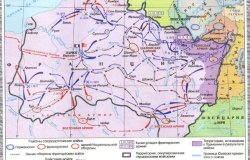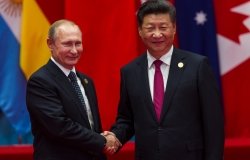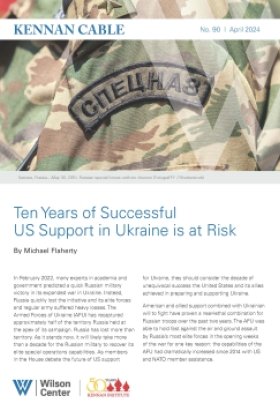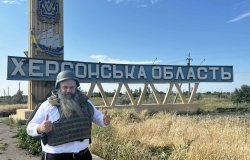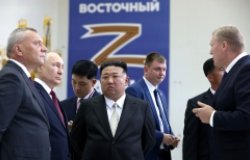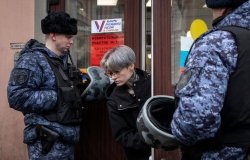Returned from Russia: Nazi Archival Plunder in Western Europe and Recent Restitution Issues
Patricia K. Grimstead, Associate, Harvard Ukrainian Research Institute, Harvard University; Honorary Fellow, International Institute of Social History, Amsterdam; Michael Kurtz, Assistant Archivist for Records Services, U.S. National Archives; Robert Wolfe, Senior Archivist (retired), U.S. National Archives
Overview
During World War II, Nazi Germany seized archival records throughout Europe to aid in operations related to occupation and conquest, analysis of the enemies of the regime, or simply as items of plunder. Many of these archives were in turn captured by the advancing Soviet Army during the closing months of the war and taken back to the Soviet Union. While some archives have been repatriated to their country of origin, many remain in Russia today, according to Patricia Grimsted, associate, Harvard Ukrainian Research Institute, Harvard University, and honorary fellow, International Institute of Social History, Amsterdam. These "displaced archives," so called to avoid offending Russian sensibilities during negotiations for their return, are viewed by many in Russia as legitimate compensation for wartime losses.
International law stipulates that archival records captured during wartime must be returned to their country of origin, Grimsted stated. The United States had captured many archives during the war in Europe and Japan, she said, but most were returned to their country of origin by the 1960s. She noted that the Soviets had returned many captured archives to their East European clients, but stopped doing so in 1991. Grimsted observed that the Russians have a better record of returning archives than art and library collections.
Grimsted's book, Returned from Russia: Nazi Archival Plunder in Western Europe and Recent Restitution Issues, details five examples of the successful return of archives from Russia to their country of origin. In the book, she recounts the histories of each of the collections—how they were first captured by Nazi Germany, then captured by the Soviets, and the fate of each collection thereafter.
In the Soviet era, the contents and identity of archives captured from the Nazis were classified as state secrets, according to Grimsted, but now they are open to researchers. In 1998, Russia passed a law on the status of cultural items seized during World War II, officially claiming ownership as war compensation (as amended in 2000). Grimsted questioned how this law could apply to archives that originated in countries outside of the Axis such as France or Belgium. Financial compensation is the key factor in the return of archives, continued Grimsted. In the book, she recounts how France was charged large "storage fees" before it could reclaim a certain archival collection. Those fees never made it to the Russian archivists who actually maintained the collection, Grimsted later learned. She also noted that there has not been any return of German archives, which is now prohibited by Russian law.
Grimsted concluded by emphasizing the importance of encouraging the return of more wartime archives from Russia. Many of these records are the property of Russia's wartime allies, and are the only records of their kind. This process is complicated by Russian politicians, she continued, who see the artwork and archives captured during the war as symbols of their victory that are not to be returned without compensation.
In commenting on the book, Robert Wolfe noted that the United States had captured many archives during the war for analysis and copying. While the USSR began returning various records to its satellite states in 1953, the United States did not start returning files to West Germany until 1958 or later. Wolfe also noted that the integrity of captured archives is often compromised, as individual files are incorporated into different records, such as intelligence files. Many such compromised archives under U.S. control have been reconstituted and are in the process of being returned.
Michael Kurtz complimented Grimsted's book as an interesting case study for archival return and as a potential roadmap for future return efforts. Kurtz noted that the book provides insights into the motives and ideology involved in returning captured archives. Both the Nazis and Soviets first saw the operational value of the archives in terms of controlling captured territory or tracking populations. After the war, the archives came to have an ideological value as World War II transitioned into the Cold War. The failure of the allies to set a common policy on captured property, including archives, hardened the status of archives into symbols. The only way to resolve the final status of these "displaced archives" is careful diplomatic negotiations on principles and on the protocols of implementation. Even with the successful return of archives, Kurtz observed, such records will never truly be completely restored.
Hosted By

Kennan Institute
The Kennan Institute is the premier US center for advanced research on Russia and Eurasia and the oldest and largest regional program at the Woodrow Wilson International Center for Scholars. The Kennan Institute is committed to improving American understanding of Russia, Ukraine, Central Asia, the Caucasus, and the surrounding region though research and exchange. Read more

Cold War International History Project
The Cold War International History Project supports the full and prompt release of historical materials by governments on all sides of the Cold War. Through an award winning Digital Archive, the Project allows scholars, journalists, students, and the interested public to reassess the Cold War and its many contemporary legacies. It is part of the Wilson Center's History and Public Policy Program. Read more
Thank you for your interest in this event. Please send any feedback or questions to our Events staff.
